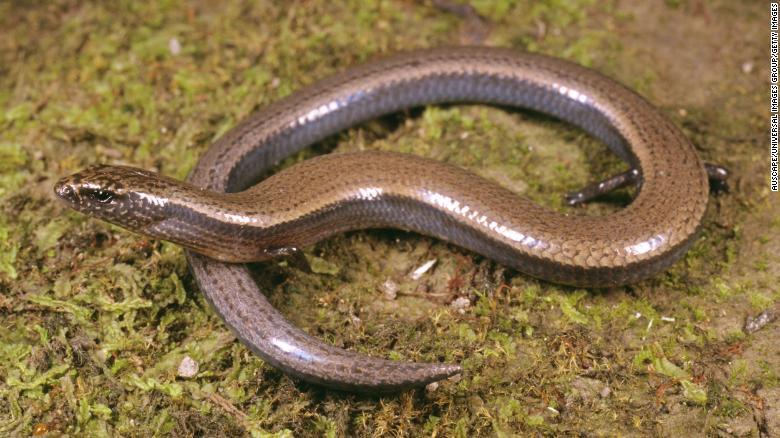» Site Navigation

1 members and 1,448 guests
Most users ever online was 47,180, 07-16-2025 at 05:30 PM.
» Today's Birthdays

» Stats

Members: 75,937
Threads: 249,129
Posts: 2,572,292
Top Poster: JLC (31,651)
|
-
Decisions, decisions...when evolution has to decide
This is pretty interesting!
https://www.cnn.com/2020/04/11/us/sk...rnd/index.html
An extraordinary feat pulled off by a lizard could suggest the species is going through a rare evolutionary transition

By Harmeet Kaur, CNN
Updated 12:28 AM ET, Sat April 11, 2020

Three-toed skink, Saiphos equalis, Craven, New South Wales, Australia (Photo by: Auscape/Universal Images Group via Getty Images)
(CNN)For most of the animal kingdom, babies are born in one of two ways: their parent either lays eggs or gives birth to live offspring.
Recently, a three-toed skink (Saiphos equalis) pulled off an extraordinary feat: It laid three eggs and delivered another baby through live birth in the same pregnancy. That suggests that the lizard species is in a rare transitional form between egg-laying and live-bearing animals, according to a study published in Molecular Ecology last month.
"We affectionately call the three-toed skink 'the weirdest lizard in the world' -- but it can tell us a lot about the evolution of reproductive strategies," Camilla Whittington, one of the study's lead authors and an evolutionary biologist at the University of Sydney, wrote in an email to CNN.
It was the first record of egg-laying and live birth in a single pregnancy
Three-toed skinks, found in Australia, are already a fascinating species for evolutionary scientists, explains Whittington. One reason is that some populations reproduce by laying eggs, while others reproduce through live birth.
close dialog

Subscribe to the CNN 10 Newsletter
Help students stay informed during these unusual times. CNN 10 breaks down the days biggest stories in 10 minutes or less and provides a weekly news quiz. Sign up for the free newsletter.
Sign Me Up
No Thanks
By subscribing you agree to our
privacy policy.
But never before had scientists seen a species lay eggs and experience live birth in a single pregnancy until it was observed in the three-toed skink last year, Whittington wrote. It was the first record of a vertebrate doing so.
Why this could be happening
There are a couple of explanations as to why the skink both laid eggs and had a live baby in the same pregnancy, Whittingon said.
One is that it was a form of "bet-hedging," meaning that the ability to switch between laying eggs and live birth could provide the lizard an advantage in unpredictable environments.
"For example, if it's cold or dry, it might be risky to lay eggs in an unprotected nest, and better for the mums to carry the babies until development is complete," she wrote. "If there are a lot of predators around and pregnant mums find it harder to escape, it might be risky to carry babies to term. Mothers that are able to act flexibly could therefore have an advantage in an unpredictable environment."
Another explanation is that some feature of the environment could have caused the skink in question to lay part of her clutch abnormally early. Still, Whittington said, two of the skink's eggs hatched to healthy baby lizards, which means that if this phenomenon happened in the wild, the babies could still be viable.
Scientists don't yet know what course evolution is taking
The finding could mean that the skink is transitioning to only laying eggs or only experiencing live birth. But scientists say it's too soon to tell which direction it's moving in.
In general, animals that give birth to live young have evolved from ancestors that laid eggs and it would be rare for an animal to evolve in the other direction, according to Whittington. And it's worth pointing out that when this skink does lay eggs, the embyros are almost fully developed and hatch much more quickly than other egg-laying lizards.
Still, it's "impossible" to determine what course natural selection is taking in this skink species, Whittington said. Their research shows that the uterus of the "transitional" three-toed skinks and live-bearing three-toed skinks function similarly, which could make it possible for the species to reverse from live-bearing to egg-laying, she said.
"At the moment, we can't rule out the possibility that the transitional animals could be descended from live-bearing ancestors -- which is why we are continuing to study these amazing lizards," she wrote.
"To complicate things, if the environment changes, the direction of selection could change too! In some environments, natural selection might favor laying eggs. In others, it might be more advantageous to give birth to live young."
And that, Whittington said, is what makes evolution such a fascinating process.
Rudeness is the weak man's imitation of strength.
Eric Hoffer (1902 - 1983)
The greatness of a nation and its moral progress can be judged by the way its animals are treated. ~ Gandhi
-
The Following 4 Users Say Thank You to Bogertophis For This Useful Post:
Craiga 01453 (04-11-2020),GoingPostal (04-12-2020),Kam (04-11-2020),vivi (04-11-2020)
 Posting Permissions
Posting Permissions
- You may not post new threads
- You may not post replies
- You may not post attachments
- You may not edit your posts
-
Forum Rules
|














 Reply With Quote
Reply With Quote